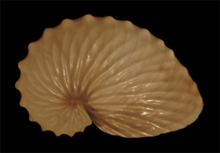Winged Argonaut
| Winged argonaut | |
|---|---|
 |
|
| Eggcase of Argonauta hians | |
| Scientific classification | |
| Kingdom: | Animalia |
| Phylum: | Mollusca |
| Class: | Cephalopoda |
| Order: | Octopoda |
| Family: | Argonautidae |
| Genus: |
Argonauta Linnaeus, 1758 |
| Species: | A. hians |
| Binomial name | |
|
Argonauta hians Lightfoot, 1786 |
|
| Synonyms | |
|
|
Argonauta hians, also known as the winged argonaut, muddy argonaut or brown paper nautilus, is a species of pelagic octopus. The common name comes from the grey to brown coloured shell. The Chinese name for this species translates as "Grey Sea-horse's Nest". The female of the species, like all argonauts, creates a paper-thin eggcase that coils around the octopus much like the way a nautilus lives in its shell (hence the name paper nautilus). The eggcase is characterised by a wide keel that gives it a square appearance, few rounded tubercles along the keel, and less than 40 smooth ribs across the sides of the shell. The shell is usually approximately 80 mm in length, although it can exceed 120 mm in exceptional specimens; the world record size is 121.5 mm.
A. hians is cosmopolitan, occurring in tropical and subtropical waters worldwide. It is an extremely variable species and there appear to exist at least two distinct forms; a "southern" form and "northern" form (see images). The former is most abundant in the Philippines and South China Sea. It is a much smaller animal, with a shell that rarely exceeds 80 mm and lacks the winged protrusions for which this species is named. The "northern" form, which is found in the waters surrounding Taiwan, Hong Kong and Japan, produces a much larger, darker and more robust shell that can reach 120 mm and has the characteristic winged protrusions. It is usually less elongated than that of the "southern" form and lacks its porcelain-like shine. Further research is needed to determine whether these forms represent two separate species or not.
A. hians feeds primarily on pelagic molluscs. Remains of heteropods have been reported from the stomachs of A. hians. The species is preyed on by numerous predators. It has been reported in the stomach contents of Alepisaurus ferox from the south-western Pacific.
...
Wikipedia

